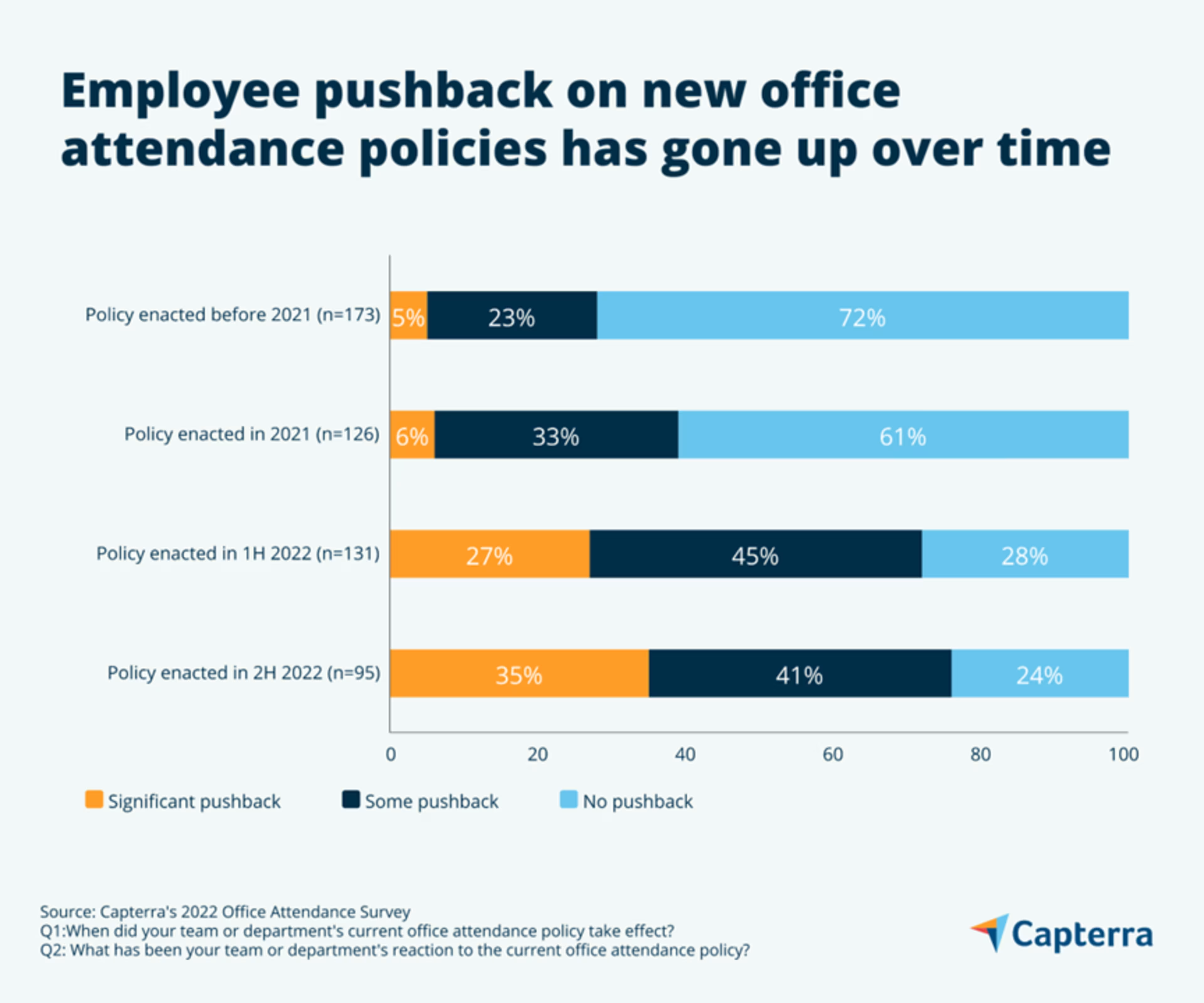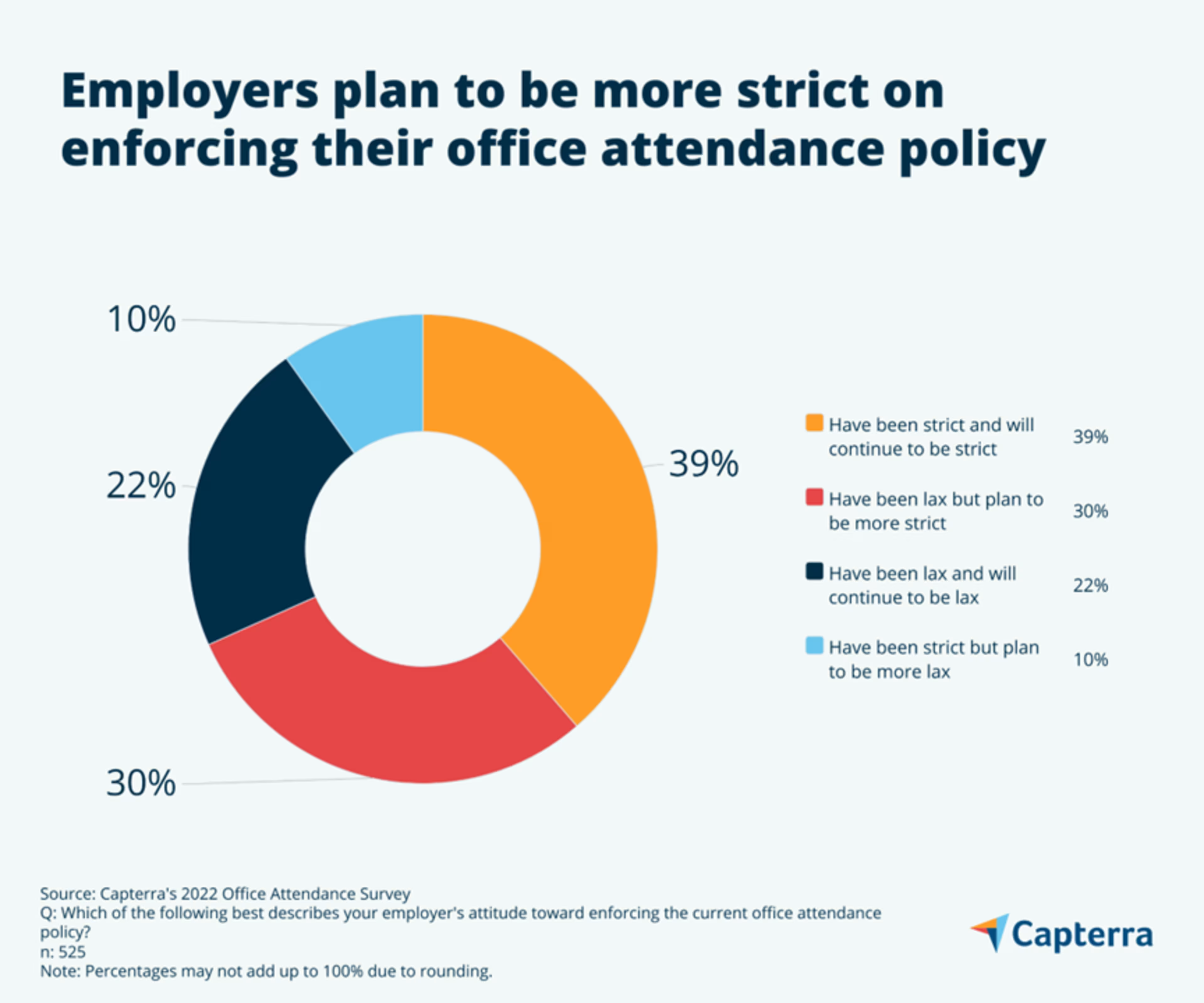More companies are playing hardball to get employees back in the office. Should you?
This year, hybrid companies have struggled to get employees to return to the office on a consistent basis. Perks like free food and pop-up events haven’t been enough[1] to entice workers back on their own. Now, a Capterra survey* reveals that employers aren’t letting lackluster office attendance slide any longer.
According to responses from over 500 managers at companies requiring employees to be in the office at least once per week, 69% already are or plan to be more strict on enforcing their office attendance policy. Managers say that not only will they track office attendance and factor that attendance into performance reviews, but—in some cases—have already fired employees that didn’t come into the office as much as required.
This “push” approach to hybrid work (as opposed to a “pull” approach of enticing workers to return the office voluntarily) is gaining momentum among frustrated employers, but can backfire easily if they aren’t careful. Below, we’ll reveal our survey results and offer advice on how HR leaders can successfully get workers back to the office without hurting employee morale or retention.
/ Key findings
Workers are skirting office attendance requirements: Only 42% of managers who require employees to be in the office at least once per week estimate that their entire team or department is fully complying with the office attendance policy.
Companies aren’t letting poor attendance slide any longer: 69% of managers say they already are or plan to be more strict on enforcing their office attendance policy.
Managers are stepping up efforts to enforce office attendance: 81% of managers say they already have or plan to track employee office attendance, and 74% already have or plan to factor office attendance into employee performance reviews.
Employees that resist office attendance requirements could lose their job: More than one in four managers (27%) say they have fired at least one employee this year because of poor office attendance.
Employee resistance to hybrid policies has led to subpar office attendance
On at least one point, most hybrid employers and employees agree: Some time in the office for collaboration, culture-building, or simply getting a break from working at home is a good thing.
The particulars of how often employees should be in the office vs. at home, however, and whether employees should be required to be in the office on specific days remain points of contention.
Last year, for example, 69% of small-business decision-makers told Capterra** they’d prefer employees to be on-site three or more days per week. Seventy-six percent of small-business employees, on the other hand, said they’d prefer to be on-site three or fewer days per week.
With management and staff not on the same page, workforce resistance to office attendance requirements—especially those made effective this year—has been stiff. Among surveyed managers at companies that have implemented office attendance requirements in the second half of 2022, 76% say there has been at least some pushback from their team or department on the policy.

In practice, this resistance has taken the form of employees going into the office less often than company policy dictates. When asked what percentage of their team or department they estimate is fully complying with their office attendance policy, only 42% of surveyed managers estimate their entire team is fully compliant. On average, managers say 85% of their team is fully compliant—a number that doesn’t seem all that alarming today, but would certainly raise a red flag pre-pandemic.
Further analysis reveals the types of companies and teams that are particularly struggling with office attendance this year:
Large companies: Managers at companies with over 1,000 employees estimate only 81% of their team, on average, is fully complying with their attendance policy, vs. 92% for managers at companies with 100 or fewer employees. With more employees to keep track of, workers at bigger companies feel they can more easily fly under the radar and skirt office requirements.
Companies with looser policies: Managers estimate only 80% of their team, on average, is fully complying when they have to be in the office one day per week, vs. 91% when workers have to be in the office five days per week. Interestingly, the lower the office time requirement, the more likely an employee is to break the rules.
IT companies and departments: Managers at IT service and software companies estimate only 78% of their team, on average, is fully complying with their attendance policy—the lowest average for any industry with at least 30 responses in our survey. For managers in IT departments, the number is similarly low: 80%. We chalk this up to IT work being particularly suited for a work-from-home environment.
The days of lax office attendance enforcement are over
Though office attendance hasn’t been up to snuff, employers have been reluctant to enforce attendance requirements so far this year because of four motivating factors:
With productivity unaffected or even improved by working from home in a lot of cases, companies haven’t seen enough of a performance drain to warrant stricter enforcement of office attendance requirements.
In a red hot job market that’s averaging two job openings for every job seeker, managers haven’t been keen on forcing their teams back to the office out of fear of them quitting for more flexible opportunities elsewhere.
When notable companies like General Motors and Apple enacted in-office attendance requirements, the ensuing employee backlash made headlines.
The ongoing COVID-19 pandemic still carries some risk for in-person interactions.
But our survey indicates this mindset is beginning to change. While 52% of managers say their employer’s attitude toward enforcing their office attendance policy has been lax, 69% indicate they already are or plan to be more strict with enforcement.

What prompted the change? For one thing, the hot job market is starting to show signs of slowing down, meaning employers are feeling better about being able to retain workers, even with office attendance requirements. Additionally, while working from home hasn’t been a drain on productivity, research shows it has hampered collaboration[2] —something companies are eager to get back on track.
But perhaps the biggest reason for this switch is because the initial “pull” approach of enticing workers back to the office on their own has been largely ineffective. For many workers, the pros of free food, fun events, or seeing co-workers in person haven’t been enough to outweigh cons of office life such as long commutes and distracting work environments.
Companies are prepared to punish employees that don’t come into the office
In order to more strictly enforce office attendance requirements, companies are prepared to bring down significant punishments on employees who don’t cooperate. In our survey, 81% of managers say they already have tracked or plan to track their team’s office attendance, and 74% say they already have or plan to factor that attendance into performance reviews.
That’s not all though: 46% say they have docked or plan to dock pay or benefits, while 27% have gone as far as firing an employee this year because of poor office attendance.

If employers are dead set on getting employees in the office more often, the threat of getting a bad performance review, losing their benefits, or being out of a job will undoubtedly motivate employees to comply.
That being said, those who hope workers will “get over it” and accept losing work time at home on a regular basis run serious risks. If attendance requirements are too strict, too punishing, or poorly rationalized, companies could quickly lose top talent to competitors who are more accommodating.
4 tips to get employees (happily) back in the office
HR leaders intent on getting employees back in the office more frequently have a real dilemma on their hands. The “pull” approach to make the office more enticing hasn’t swayed people enough to give up working from home as often as anticipated, but the “push” approach of punishing employees who don’t come in threatens to create a disgruntled workforce that will seek out more flexible opportunities elsewhere.
How can you get workers in the office more often without disengaging them? Here are four tips:
1. Understand why workers would prefer the office over working from home
As much as employees are clinging to remote work, it isn’t perfect. Whether workers are looking for a better internet connection, a working printer, a place to learn and grow, or simply a change of scenery, understanding what makes your office the superior choice in some cases and communicating that to employees will motivate them to come in more often. (That is, if you have an office actually built to meet their needs.)
2. Avoid appearing hypocritical
Part of the reason employees have been resisting the call to return to the office is the belief that company executives aren’t practicing what they preach, and research shows they’re not wrong. An April 2022 survey[3] found that while 35% of non-executives were commuting into the office each day, only 19% of executives were doing the same.
If you’re requiring employees to come into the office, ensure that employees at all levels are actually following through. If a worker has to come in, but their boss is still staying home, resentment will set in.
3. Schedule days for everyone to gather (but not always in the office)
In the debate over whether employees should be required to come into the office on specific days or not, there is no good answer. Enforce requirements that guarantee an entire team will be in the office together on specific days to collaborate, and employees will scoff at the lack of flexibility. Give workers the freedom to come in when they’d like, however, and they’ll be discouraged when no one on their team is there with them.
To find a happy medium, have managers plan for specific days—be it once per month, once per week, or more frequently—for their entire team to come in at the same time. Instead of having every team day in the office, however, managers should bake in regular offsites to combat office fatigue. Meeting in a neutral location can not only encourage collaboration and creativity, but also put employees more at ease by being outside of an employer-controlled environment.
Finding the right day for a team to gather together can be a pain through email. Use a shared calendar or a collaboration tool instead to quickly ensure everyone’s on the same page.
4. Always allow for exceptions
Though the COVID-19 pandemic may feel over for most employees at this point, for the immunocompromised, the virus still carries very real health risks. On top of that, you likely have employees with disabilities who not only have a home that better accommodates their work needs, but who tackle extra hurdles in getting to and working comfortably in an office.
All that to say, there will always be workers who will unilaterally perform better and feel safer staying home—lead with empathy and don’t force them into the office.
A human resource management system (HRMS) is a must to keep track of all the exceptions here. You can add any communicated disabilities or necessary accommodations for each employee directly to their profile so every manager is aware. Check out some of the top-rated HRMSs here.
Did you like this report? If so, check out some of our other resources on hybrid work:
